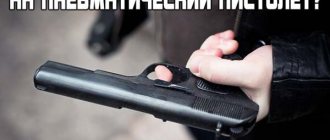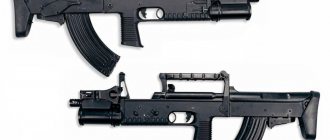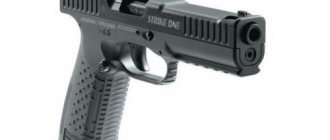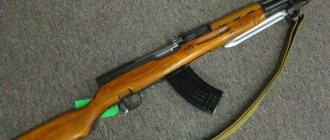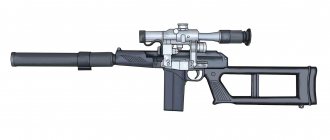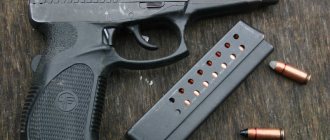| PSM | |
| Type | self-loading pistol |
| A country | USSR |
| Service history | |
| Years of use | since 1972 |
| Adopted | 1973 |
| Wars and conflicts |
|
| Production history | |
| Designed by | 1971 |
| Manufacturer | Izhevsk Mechanical Plant |
| Years of production | since 1972 |
| Options | IZH-75 (version chambered for 5.45x18 mm), Baikal-441 (version chambered for 6.35x15 mm Browning) |
| Characteristics | |
| Weight, kg | 0,460 |
| Length, mm | 155 |
| Barrel length, mm | 84.6; six rifling |
| Width, mm | 18 |
| Height, mm | 117 |
| Cartridge | 5.45×18 mm |
| Work principles | blowback |
| Initial bullet speed, m/s | 315 |
| Sighting range, m | 25 |
| Type of ammunition | 8-round box magazine |
| Aim | open permanent |
| Media files on Wikimedia Commons | |
PSM
(Small-sized self-loading pistol, GRAU index - 6P23) is a self-loading pistol developed by a team of designers from the Tula TsKIB SOO (T. I. Lashnev, A. A. Simarin and L. L. Kulikov) chambered for 5.45x18 mm.
It was created on instructions for the development of a small-sized pistol for arming the senior command staff of the Soviet Army, operational groups of the KGB of the USSR and the Ministry of Internal Affairs of the USSR. The main requirements were minimum dimensions and weight with no protruding parts. Work on the creation of weapons was carried out from 1970 to 1972. After state tests, the PSM pistol was adopted by the KGB of the USSR and the Ministry of Internal Affairs of the USSR in 1974. In the same year, its mass production began.
In the post-Soviet space, PSM is still used as a weapon for operational law enforcement officers and intelligence agencies, as well as a self-defense weapon for constant wear by army generals and the leadership of security forces.[1] It is also a reward weapon.
Description
Compact and flat, the PSM is optimized for concealed carry. PSM differs from other small-sized pistols in its high penetration effect due to a specially designed cartridge. The pistol used a new 5.45x18 mm cartridge.
In general, the pistol has proven itself to be a trouble-free, easy-to-use, safe, accurate and durable weapon throughout its entire operation.
Design
Automation works according to the scheme of using recoil with a free shutter. Trigger-type trigger, double action, with automatic safety cocking. Once all the cartridges have been used up, the bolt enters the slide stop. On the left side of the bolt there is a safety lever, which is also a lever for safely decocking the hammer. When on, the safety locks the hammer, trigger and bolt. The magazine latch is located at the bottom of the handle.
On Soviet-made PSM, the handle cheeks are made of aluminum alloy; later, plastic cheeks with a more convenient shape were put into production.
However, this pistol had one unpleasant feature. If it was necessary to put the weapon on safety, the trigger would break and pinch the thumb. From this injury it was always possible to identify the owners of the first PSM.
High penetration allows you to confidently hit a target behind light cover or in first-class body armor, and the flat flight path contributes to more uniform aiming when shooting at different distances. The disadvantage of the PSM pistol is the weak stopping effect of a small-caliber bullet.
Minuses
According to weapons specialist A. Blagovestov, bullets from a small-sized self-loading pistol have a rather weak stopping effect (unless they hit vital human organs). Sometimes the enemy could continue to shoot, even if a bullet from the PSM went right through his body.
The model is difficult to remove from the safety catch; if the trigger is not cocked, the owner may damage a nail or injure a finger.
Finally, the small-caliber centerfire (MCF) ammunition used in the PSM is quite difficult to find.
Options and modifications
In the 1990s, the Izhevsk Mechanical Plant began producing commercial versions of the PSM pistol for export:
- IZH-75
(export model -
IZH-75
, later
MP-75
) - commercial model chambered for 5.45x18 mm. - Baikal-441
is a commercial model chambered for 6.35x15mm Browning (.25 ACP). It differs from the base model in having thicker grip cheeks, an adjustable sight and an indicator for the presence of a cartridge in the chamber.[2]
Traumatic and gas pistols
In the 1990s, 6P37 and IZH-78
.
Somewhat later, the IZH-78-9T
chambered for the 9 mm R.A. cartridge was created.
Another traumatic pistol, PSM-R chambered for 9 mm RA cartridge, is produced by the SOBR enterprise (Kharkov, Ukraine) by converting used PSM combat pistols.
Small-sized self-loading pistol PSM
The small-sized self-loading pistol, abbreviated as PSM, was developed at TsKIB SOO in Tula by a team of designers consisting of T.I. Lashnev, A.A. Samarin and L.L. Kulikov. in 1970-1972. The pistol was created on the basis of TTT approved by the military-industrial complex under the Council of Ministers of the USSR. The main requirement was “flat, without protruding parts on the side surfaces; thick as a matchbox (17mm), lightweight, weighing with a loaded magazine no more than 0.5 kgf, with overall parameters - length 155 mm, height 106 mm, thickness 17 mm.”
In 1972, a pistol with a factory index of 6p23 was put into service the first time, without making any modifications. As conceived by the designers, the pistol was intended to arm the army's top commanders, but its high efficiency with small dimensions and weight made it popular among security forces and law enforcement officers. The combination of these qualities also makes it an ideal weapon for self-defense.
PSM began to be produced in 1974 at the Izhevsk Mechanical Plant.
For this pistol, designer A.D. Denisova developed a new MPTs cartridge (5.45*18), the mass of which was 4.8 g, the bullet - 2.5 g, the initial speed of the bullet was 300-315 m/s.
It should be noted that over more than 30 years of production, the PSM pistol has not undergone any modernizations or modifications, with the exception, perhaps, of the handle shell.
The first PSMs had an aluminum handle, but to improve the ergonomics of the pistol, it was soon decided to replace the handle with a plastic one. The pistol became 2 mm thicker, now its width was 20 mm, but this was a small price to pay for improving its grip. All modifications of PSMA produced and currently produced are equipped with a plastic handle.
Type - automatic based on blowback recoil, self-loading
Caliber - 5.45 mm
Length - 155 mm
Barrel length - 85 mm
Weight - 0.46 kg
Magazine capacity - 8
The operating principle of the automatic PSM is based on the recoil of the free shutter-casing during a shot. The bolt return spring is mounted on the barrel. There is a notch on both sides of the shutter surface. The impact mechanism is an open trigger with a screw mainspring and a curved trigger rod. This design of the trigger mechanism allows for single fire, both with self-cocking using special protrusions on the trigger rod, and with pre-cocking of the hammer. The safety flag protrudes from the rear of the bolt, allowing you to cock the hammer and slide the safety with one movement of your thumb.
The trigger has a safety cock. This makes it possible to carry a weapon ready to fire with the safety off. The safety lever blocks the sear and trigger in the forward position, thereby releasing the hammer from cocking and disconnecting the firing pin from interacting with the hammer.
The PSM handle has a flat 8-round magazine. The single-row walls are made with large side windows. They move a feeder with notched projections, which ensures easy loading of the magazine. It is impossible to disassemble the pistol without removing the magazine, since the rear protrusion of the trigger guard rests against the front wall of the magazine.
The pistol has a flat, compact shape and smooth contours without parts protruding to the side, which makes concealed carry easier and allows you to easily remove the weapon if necessary. The pistol is perfectly balanced, and the convenient location of the controls allows you to easily operate the weapon with one hand. A distinctive feature of the pistol is the handle, made of a metal alloy and secured to the frame with a stopper.
The PSM pistol is a melee weapon, and is excellent for performing special tasks and self-defense.
Special forces fighters use PSM as an auxiliary weapon. It should be noted that the flat and small-sized handle makes the PSM fit in the palm insufficiently tight. You have to press the trigger with the middle, and not the front, phalanx of the index finger, which worsens the practical results of shooting.
The designers of TsKIB developed a modernized version of the PSM, which is produced and designated IZH-75. It differs from the PSM in having an elongated barrel and a wider handle.
Gas pistol 6p37.
In 1993, with permission for Russian citizens to purchase gas weapons, the production of domestic gas pistols was launched, which differed favorably from foreign models in that they were made of weapons-grade steel. As in the case of the PM, when developing the gas PSM, they did everything simply: they took a regular combat PSM, installed a chamber sleeve for a specially designed 7.62 mm gas cartridge. The trunk was smooth throughout.
There was no need to redo the shutter, because this cartridge was developed on the basis of the MPC cartridge, only instead of a bottle shape it received the usual cylindrical shape and its barrel was clamped in the form of an asterisk. The pistol was named 6p37.
The production of a new modification of the gas PSM was due to the fact that the 6p37, falling into criminal hands, could very easily be converted into a combat pistol, both chambered for 5.45 mm and 6.35 mm. To do this, it was enough to remove the separator, the muzzle sleeve and drill the barrel for these cartridges. Therefore, the Izh-78 was distinguished by a thinner barrel made of inferior steel. Due to the design features of the PSM, it was no longer possible to weaken the pistol.
Now it was the other way around: the gas Izh-78-8 was produced en masse, and the Izh-78-7.6 was produced in separate batches. It should be noted that in terms of reliability, the 8mm modification of the Izh-78 is much more reliable than the similar 8mm version of the Izh-79 due to the more suitable length and width of the magazine for an 8mm gas cartridge.
But the constant criminal conversions of the gas-powered Izh-78 into a combat pistol, as the most suitable for this purpose from the entire range of pistols produced, led to the fact that the Izh-78 abruptly disappeared from the assortment of gun stores at the beginning of 2000.
Also at the beginning of 2000, the pistol magazine underwent some changes: its cover began to be made of plastic, and it received a slightly different shape, more convenient for the little finger of the shooting hand.
In the fall of 2004, a new modification of the PSM pistol, more precisely the gas Izh-78 - Izh-78-9T chambered for a 9mm-RA caliber cartridge with a rubber bullet, appeared in the Kolchuga weapons store. This pistol received its own name 'Kolchuga', after the name of the store of the same name that pushed the pistol onto the civilian market. Unlike the usual gas Izh-78-7.62/8, this pistol received a 9-RA caliber. In connection with this, the magazine body was changed (the thickness of the walls became smaller, the cutout in the side walls changed), the feeder became a little thicker, having a different shape. Due to the use of a 9mm cartridge, the magazine capacity became only 6 rounds, although by making the feeder yourself, the capacity can be increased to 7 rounds (it’s strange that this was not done at the factory). Also, due to the use of a 9mm cartridge, the thickness of the walls of the barrel post has decreased significantly, but has sufficient strength for firing a cartridge with a rubber bullet.
By the way, I would like to note that the Izh-78-9T pistol is more like a combat pistol than any other gas, or gas-powered pistol. It can only be distinguished externally by its factory marks.
The channel of the pistol barrel has two protrusions, which have already become standard, in order to prevent the possibility of firing anything harder than a rubber ball, and also to keep the muzzle energy of a shot with a factory cartridge within 40 J.
Today IZH-78-9T is one of the popular pistols for self-defense.
In service
- Abkhazia - in service with employees of the Ministry of Internal Affairs, the State Security Service, the State Customs Committee, the Ministry of Defense and the Government Communications Agency of the Republic of Abkhazia.
- USSR USSR
- Russia Russia is in service with the tax police[3], the Federal Security Service of the Russian Federation, the courier service and collectors[4], in December 1998 it was adopted by the Federal Bailiff Service[5], since 1999 it has been in service with the Prosecutor's Office of the Russian Federation as a weapon of self-defense for prosecutors and investigators[6]. In December 2005, it was included in the list of award weapons[7].
- Belarus Belarus - customs authorities[8];
- Kazakhstan Kazakhstan is the financial police[9].
- Kyrgyzstan Kyrgyzstan is a reward weapon[10]
- Mongolia Mongolia[11]
Based on the sports model
PSM
Several domestic weapons engineers (A. Simarin, L. Kulikov) under the leadership of T. Lashnev worked on the development of PSM for 5 years (1969 - 1974). The famous researcher of Soviet firearms, Doctor of Historical Sciences D. Bolotin noted that the sports PS became the basis for PSM. The latter, for target shooting, was previously created by the same 3 gunsmiths.
According to A. Simarin, the most difficult thing was to achieve the creation of a tiny, light and thin weapon with decent destructive power and performance characteristics, reliability under any conditions, incl. in the cold, in the heat and in the mud. The designer said that the three of them managed to implement this by coming up with PSM.
Experimental models of the pistol immediately passed testing. No modifications were needed, which happened quite rarely.
Notes
- Blagovestov A.I.
What they shoot from in the CIS: Directory of small arms. / edited by A.E. Taras. Mn.: “Harvest”, 2000. pp. 78-80 - PSM, 5.45-mm small-sized self-loading pistol - WEAPONS OF RUSSIA, Catalog of weapons, military and special equipment
- Decree of the Government of the Russian Federation No. 362 of April 23, 1993 “On approval of the list of special means, types of firearms and ammunition in service with the tax investigation authorities of the Russian Federation”
- “ Organizations and their territorial subdivisions can use the 5.45 mm PSM pistol until decommissioned due to technical condition
” Decree of the Government of the Russian Federation N 460 of April 22, 1997 “On measures to provide legal entities with special statutory tasks with combat hand-held small arms” ( as amended on May 29, 2006) - Decree of the Government of the Russian Federation No. 1584 of December 30, 1998 “On approval of the list of combat hand-held small arms and other weapons, ammunition and cartridges for them, as well as special means in service with the bailiff service of the Ministry of Justice of the Russian Federation”
- Decree of the Government of the Russian Federation N 708 of June 29, 1999 “List of types and models of military hand-held small arms in service with the Prosecutor’s Office of the Russian Federation and intended for the personal protection of prosecutors and investigators, and cartridges for it”
- Decree of the Government of the Russian Federation No. 718 of December 5, 2005 “On awarding weapons to citizens of the Russian Federation”
- Resolution of the Council of Ministers of the Republic of Belarus No. 202 of February 19, 2003 “On approval of the list of special means, types of firearms, ammunition and explosives used by the customs authorities of the Republic of Belarus”
- Decree of the Government of the Republic of Kazakhstan No. 163 of February 17, 2003 “On approval of the norms and list of weapons and special means that employees of the financial police have the right to use”
- Seven deputies of the Kyrgyz parliament received award pistols from the president. // news agency "CentrAsia" dated April 4, 2007
- Jones, Richard D. Jane's Infantry Weapons 2009/2010
. Jane's Information Group; 35 edition (January 27, 2009). ISBN 978-0-7106-2869-5.


